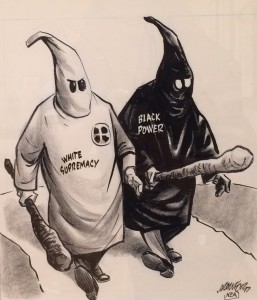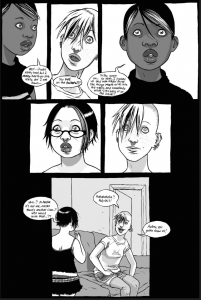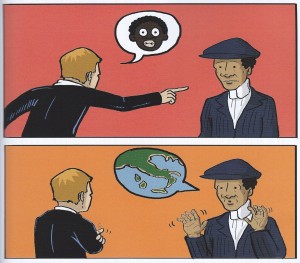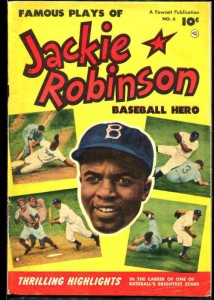Public outrage over the killing of 18-year-old Mike Brown in Ferguson, Missouri continues to amass its own tragic iconography. Handprints transform the so-called universal sign of surrender into a stronghold of dissent: “Hands up, Don’t shoot.” Hashtag memorials shape the interconnectivity of social media into a pictorial chorus of text: #BlackLivesMatter #JusticeforMikeBrown #ShutItDown. I think about my own son at two years old and already curling his brown fingers into Spider-Man web shooters, and vainly I hope that the right counter-visual will fix what’s wrong, or at least begin to impair what Matthew Pratt Guterl, refers to as “the familiar grammar of racial sight, through which a wallet becomes a gun or a Harvard professor becomes a burglar.”
I also had the chance to consider how the call for racial justice registers through image when I toured the exhibit on “The Long March: Civil Rights in Cartoons and Comics” at OSU’s Billy Ireland Cartoon Library & Museum last month. Among the stately commemoration of landmark firsts – including incredible pages of original art from Pogo, Wee Pals, and Green Lantern/Green Arrow – the corner of the room displaying the editorial cartoons seemed louder and more demanding in their effort to picture the raucous discord of the moment. We can learn a great deal from the way Pittsburgh Courier cartoonist Sam Milai uses the Junior Astronaut Helmet as a visual metonym for the aspirations of a middle-class African American family (below), only months after Neil Armstrong walked on the moon:
In another image, Bill Crawford speaks to fears over militant Black Nationalism in a cartoon that invokes the Ku Klu Klan to set the boundaries of acceptable (and respectable) protest in 1968:
So I’m interested in what editorial cartoons and other comics have to say about Ferguson. What images are deployed to convey the stakes of the debate, the challenge to people and institutions of power, and the costs of the status quo? Nationally-circulated examples can be found in features like Michael Cavna’s recent Comics Riffs column in the Washington Post on “15 of the Most Striking #Ferguson Cartoons so far…” while cartoonist Daryl Cagle is also maintaining an extensive archive on editorial comics about Ferguson on his website, The Cagle Post.
What surprises me when I browse through these cartoons, however, is how unsatisfying many of the images are, or rather how limited they appear to be in their imaginative scope. In the wake of the grand jury’s decision not to indict Officer Darren Wilson for Mike Brown’s murder, many of these editorials seem to recycle the familiar visual codes and contexts of justice denied. The irony of depicting Lady Justice, Uncle Sam, Martin Luther King, Jr., or President Obama with their hands up, unarmed, or being shot is frankly worn thin. (Though I admit to being fascinated by the current trend of depicting King as he appears in his national monument, which gives him the foreboding presence of an establishment figure or institution, rather than a fellow activist.)
Patrick Chappatte’s “Race in America” (above) is much more compelling. President Obama is depicted in the center of the sepia-colored cartoon silently watching the Ferguson protests on TV. I’m struck by juxtapositions here, beginning with the President’s quiet reflection in an empty room against the noise and chaos of the live feed. While the Oval Office seal and desk mark his distance from the populace, he is seated on the edge of the chair, close to the screen. And finally, the fact the President is a black man watching racial injustice play out before him brings the title of the cartoon into conversation with multiple registers of power and powerlessness. There is contemplation, sadness, or is that disappointment? I like the understated complexity of this piece.
Several of the comics adapt iconography commonly associated with the racism and state-sanctioned bigotry of the American South. Among these, I appreciated Matt Wuerker’s efforts to complicate the way we think about privilege by replicating the familiar “White” and “Colored” entrances of Jim Crow alongside a new door marked “Blue” with an escalator accessible only to law enforcement.
Particularly problematic, however, are the comics that lean on images of the Ku Klux Klan like a visual crutch to characterize the nature of the treatment Mike Brown and his family have received. What role does region play in such a national epidemic of injustice? When I raised this concern among friends, I was reminded of the Klan’s national reach, especially in Midwest states like Indiana in the earlier 20th century. St. Louis, in particular, seems to defy geographic labels and has been called “the most northern Southern city and the most western Eastern city.” Cartoons such as Milt Priggee’s “Ferguson hood” or Rainer Hachfeld’s “Ferguson 24/11” may therefore have a point in placing the Klan hood over Uncle Sam and Lady Justice to condemn white supremacist rule beyond the Mason-Dixon line. But I don’t think the same can be said for a cartoon like “Southern Justice” by Jeff Danzinger (below). He appears to draw a more direct line between racial violence in the South and the circumstances under which an unarmed black youth could be murdered in 2014 without repercussion. It is perhaps because the Klan iconography is so highly charged that the kind of analogy attempted in Danzinger’s piece (or in Bill Crawford’s earlier cartoon) can be too easily muddled.
Finally, I want to call attention to cartoonist Keith Knight who, along with Matt Bors, is producing some of the sharpest satire about race and police brutality today. (Many of their comics are collected at Daily Kos.) Knight’s work on Mike Brown so far includes “Blacker Friday”, “Sign of Progress?” and “White Riot.” He has been chronicling enough of these incidents that his comics about the shooting death of other black men such as Amadou Diallo, Oscar Grant, Trayvon Martin and Eric Garner are specific to each case and yet, virtually interchangeable. The cartoon at the top of my post titled “Police Application” first appeared in 2011, while the comic below was published in 2003.
Knight never takes his eye off the “familiar grammar of racial sight” and the disservice that this way of seeing does to our nation. In the comic called “41 Shots,” the way he places the famous Tootsie Pop commercial against the relentless visual BLAM of every bullet fired into Amadou Diallo’s body grows more chilling with each panel. Likewise, the hand in the parody of the “Police Application” cartoon is faced with what should be an easy question, but instead makes a devastating choice in refusing to see the humanity of people with black skin. Knight has turned all of these cartoons into a traveling exhibit – “They Shoot Black People, Don’t They?” – to call attention to the need to hold state and local law enforcement accountable, as he explains in this strip. He begins by saying, “every time I do a cartoon about police brutality, I hope and pray that it’ll be the last one I’m compelled to draw…”
So do I.
*
























